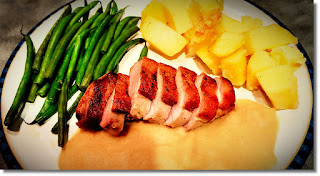Slow Cooker Pork in Soy and Mirin

Around 45 years ago, I was best of chums with a woman who loved good food and was a fine cook. But, in her view, all that cooking palaver was wasting good partying time. Now and then, she did prepare some food for one of her own parties and that usually meant large pots of decidedly tasty chilli or a strange, vaguely oriental stew of chicken or pork cooked in prodigious amounts of soy sauce. The latter was stuffed into pitta bread before being served to bemused but captive partygoers. It was a very long way from being an authentic dish but, personally, I don't think there's anything wrong with that. To this day, though, I think it just might be the saltiest and, in some ways, the oddest thing I've ever attempted to eat. Recently, I saw some pork shoulder steaks on offer in the supermarket and, for some reason, I remembered that curious, party dish. This definitely isn't an attempt to recreate it, but I think this modern version sort of captures the spirit of the origin





